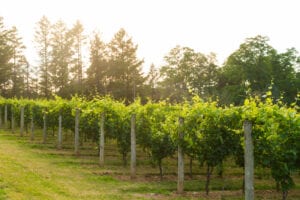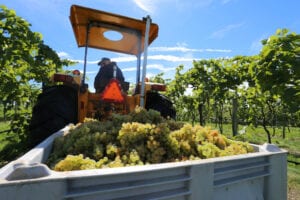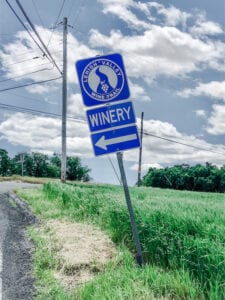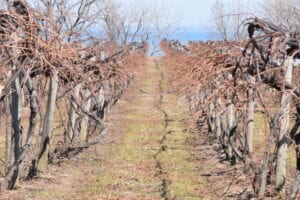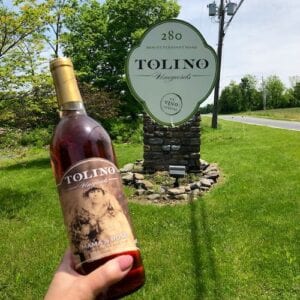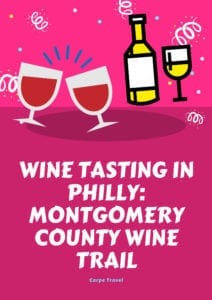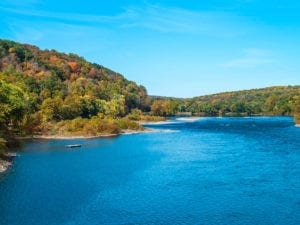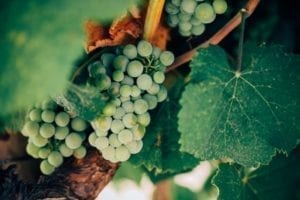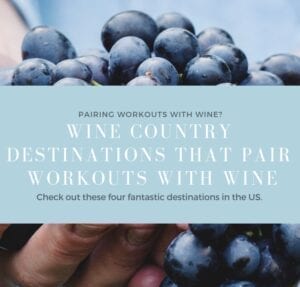Discover Pennsylvania
Wine Country
Pennsylvania wine country is everywhere in the state. No matter where you are, you’re less an hours drive to a winery. Our Pennsylvania Wine Travel Guide shares a brief history of the state's wine country, terroir, where to sip, where to stay and things to do beyond the vines.
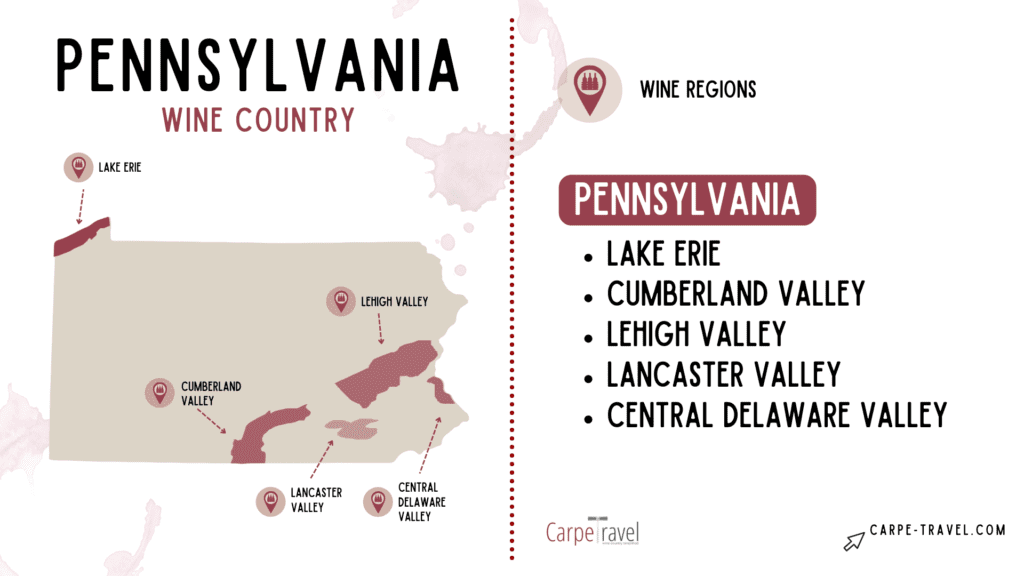
WHERE IS PENNSYLVANIA WINE COUNTRY?
The Lake Erie Grape Belt is the second largest grape growing region in the US and responsible for 72% of grape production in Pennsylvania. Towards the eastern shore you will find four additional, smaller wine regions.
BEST TIMES TO VISIT
The best time to visit Pennsylvania wineries is in the late spring/early summer when the vines are filling out and the weather isn't too hot or humid. Many wineries host outdoor events with live music and food trucks.
TOP GRAPE VARIETIES IN PENNSYLVNIA
Since the climate and soil varies greatly throughout the state, Pennsylvania can grow a considerable variety of grapes in its 14,000 plus (and growing) acres of planted grapevines.
White Wine Grapes
- Riesling
- Cayuga
- Seyval Blanc
- Albariño
- Grüner Veltliner
- Vidal Blanc
- Niagara
- Traminette
RED Wine Grapes
- Cabernet Franc
- Merlot
- Chambourcin
- Blaufränkisch (Lemberger)
- Carmine
- Teroldego
- Seperavi
The known history of Pennsylvania wine begins with William Penn. More than 300 years ago, the state’s founder planted cuttings of Bordeaux grapevines on land that is now part of Philadelphia’s Fairmount Park. Like most vineyards planted in the country’s early years, the vines didn’t survive the native bugs and diseases of the new world.
From colonial times until the early 1900s, most of the grapes grown for wine in Pennsylvania were native varieties or hybrid grapes that were heartier than the European varieties, known as vinifera. It’s not that winemakers didn’t try to grow vinifera, but they had very little success with grapes such as Cabernet Sauvignon and Chardonnay. In 1920, Pennsylvania’s wine industry came to a halt because of Prohibition. When Prohibition ended, Pennsylvania made making and selling wine almost impossible until it passed the Pennsylvania Limited Winery Act is 1968. Penn Shore Winery in Erie County was the state’s first post-Prohibition licensed winery.
By 1976, Penn Shore was one of a dozen wineries open in Pennsylvania. Today, the state has almost 300 wineries that – through science, trial and error – have discovered which vinifera can grow in Pennsylvania and which native and hybrid varieties make good wine, too.
TERROIR
Pennsylvania is home to five designated American Viticultural Areas (AVAs – wine growing regions) and more than 400 wineries. The state has 14,000+ acres of vineyards that produce more than 2 million gallons of wine every year.
There is about 300 miles between Pennsylvania’s Eastern and Western borders and 150 miles between its Northern and Southern borders. The Southeastern part of the state has maritime influences from the Atlantic Ocean with average summer temperatures of 74°F (although humidity often makes it seem much warmer).
The Northwestern part of the state is influenced by Lake Erie with average summer temperatures of 68°F and lower humidity. In between there are many mountain ranges, valleys and rivers. All of this ends end up influencing Pennsylvania’s terroir.
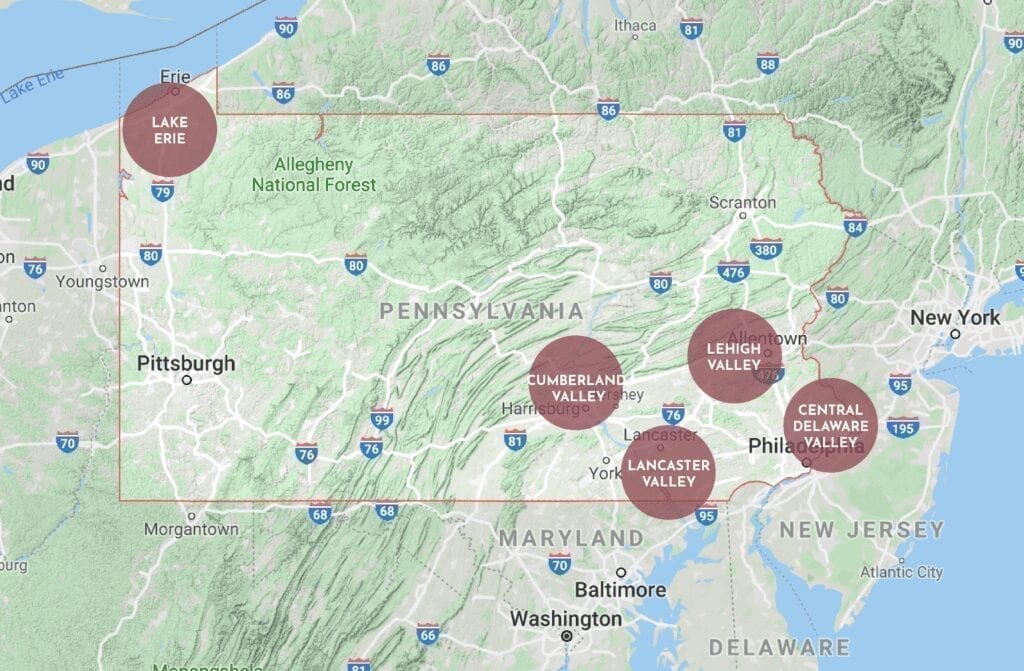
LAKE ERIE AVA
The Northwest region is home to the Lake Erie AVA. It’s generally cooler around the Lake Erie shoreline than in the rest of the state. Along the lake’s shore, a 20-mile long swath of vineyards benefit from the lake’s breezes and the consistent year-to-year weather conditions of the region.
CUMBERLAND VALLEY AVA | LANCASTER VALLEY AVA
The warmer climate in the state begins in the Southcentral region - home to the Cumberland Valley AVA and the Lancaster Valley AVA. Vinifera that require warmer temperatures can be grown here so expect to see more wines made from European grapes as well hybrids and native grapes.
CENTRAL DELAWARE VALLEY AVA | LEHIGH VALLEY AVA
You’ll find the longest growing season in the Southeast part of Pennsylvania. It’s hilly, so many vineyards drain well, and various vinifera, hybrids and native varieties flourish in this region. This region is home to the Central Delaware Valley AVA and the Lehigh Valley AVA.
WHERE TO SIP
With more than 400 wineries, the Pennsylvania wine country has a lot to sip. Wine tasting is subjective but here are a few of our favorite PA wineries for your grape escape.
Presque Isle Wine Cellars
Franklin Hill Vineyards
Heritage Wine Cellars
Planning Your PENNSYLVANIA Wine Country Vacation
PENNSYLVANIA WINE TASTING ITINERARIES
WHERE TO STAY IN PENNSYLVANIA WINE COUNTRY
LAKE ERIE
- Grape Arbor B&B
- Spencer House B&B
The Poconos
- Blue Ridge Estate B&B
- Inn at Jim Thorpe

PENNSYLVANIA WINE TRAILS
Wine trails are designed to provide a unique experience and allow you to sample different growing regions within an area. Pennsylvania has has a variety of wine trails to experience.
GETTING AROUND
Private drivers may seem like a dime a dozen, but not all those dimes are equal. Look for those who are well rated and/or ask your hotel for recommendations.
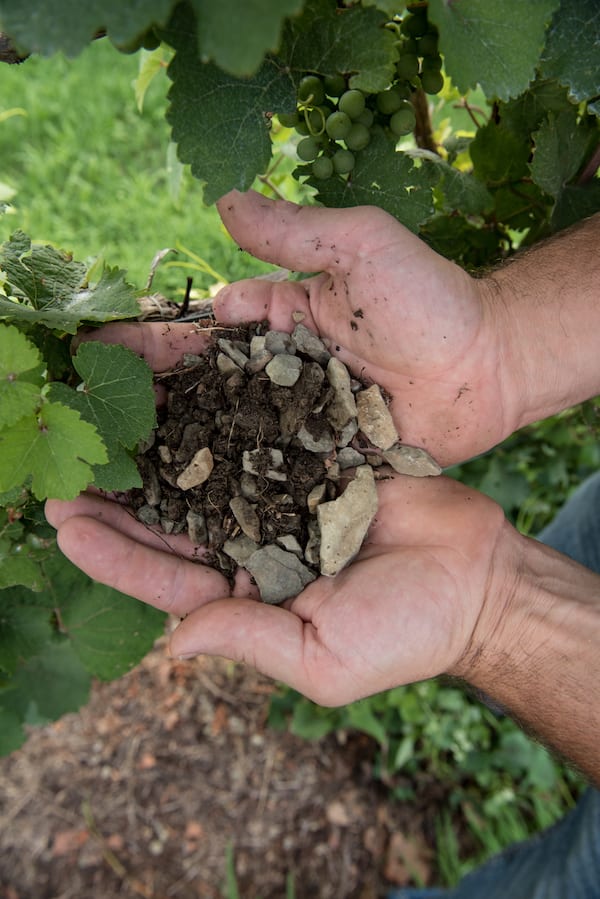
-
A family-friendly weekend of Pennsylvania wines, 250 to be exact, unique vendors, local food, and live bands. If wine isn’t your thing, head over to Brew Kids on the Block, the festival will offer a tour of Pennsylvania’s 20 or so newest breweries.
Great Tastes of Pennsylvania Wine & Food Festival
Uncork summer with the Annual Great Tastes of Pennsylvania Wine and Food Festival. This two-day outdoor festival features food and craft vendors, live musical entertainment, and samples from an estimated 30 Pennsylvania wineries. - Wine Festivals in Every State Not to Miss
BEYOND THE VINES
The five distinct wine regions in Pennsylvania are home to many fun activities, so if you’re looking for things to do besides sipping in the 300 Pennsylvania wineries, we have A LOT OF IDEAS for kids, designated drivers and those enjoying the wines of the region.
There are six United States Mint locations in the country, but visitors can only tour two, one of which is in Philadelphia. Visitors of all ages will appreciate the lessons on currency and the chance to watch money being produced.
Sip in a little cultural at one of the 30+ museums in Pittsburgh. You could spend a month exploring them. To narrow it down, try ToonSeum, Carnegie Science Center or the Carnegie Museum of Natural History.
Did you know that Pittsburgh hosted the first professional football game and the first World Series? Any season you can can a game – NFL’s Steelers, the NHL’s Penguins, and the MLB’s Pirates.
Subscribe to Sip in More of the World
Elaine Schoch is an award-winning travel writer, wine judge, American Wine Specialist and certified by the Wine & Spirit Education Trust (WSET II). At Carpe Travel she shares wine travel destination guides for ALL WINE LOVERS – from novices to experienced pros – to help them plan their wine adventures, arming them with insider tips, must-visit spots, and things to see and do beyond the vines.

